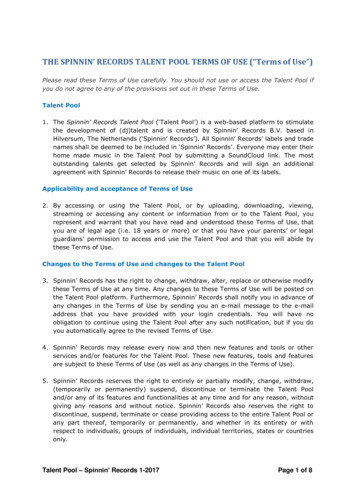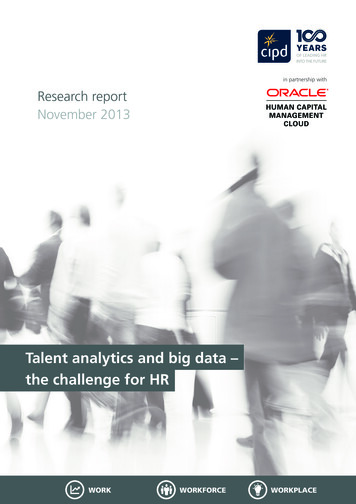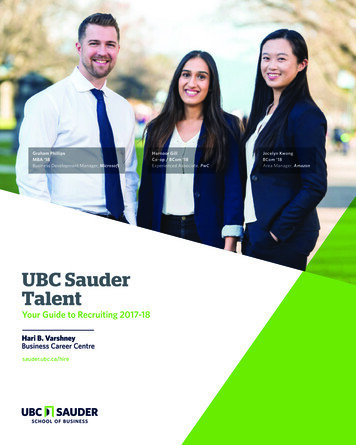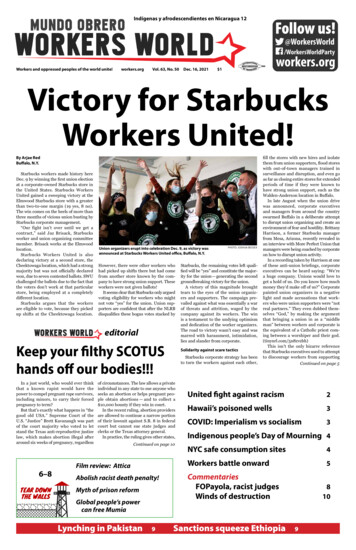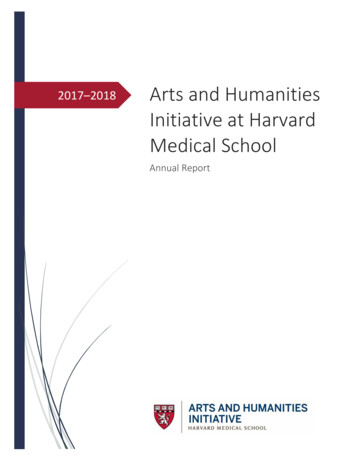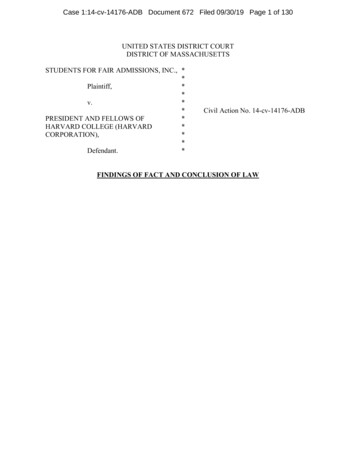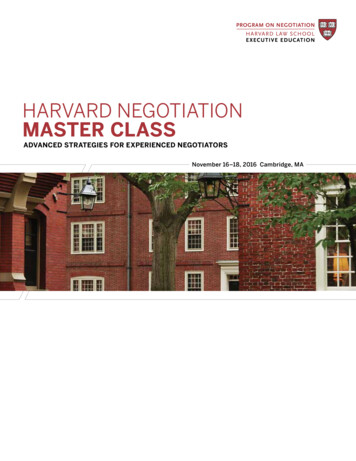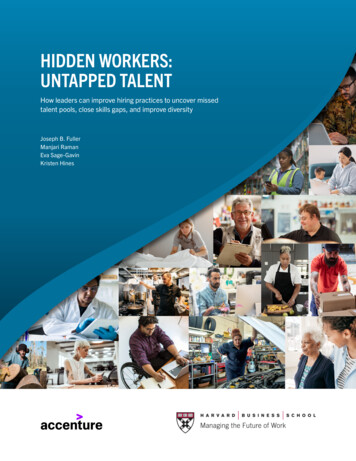
Transcription
HIDDEN WORKERS:UNTAPPED TALENTHow leaders can improve hiring practices to uncover missedtalent pools, close skills gaps, and improve diversityJoseph B. FullerManjari RamanEva Sage-GavinKristen Hines
About the authorsHarvard Business SchoolJoseph B. Fuller is a Professor of Management Practice at Harvard Business School. He co-chairs theHBS Project on Managing the Future of Work and is a visiting fellow at the American Enterprise Institute.Manjari Raman is a Program Director and Senior Researcher for Harvard Business School’s Project onManaging the Future of Work as well as the Project on U.S. Competitiveness.AccentureEva Sage-Gavin is Senior Managing Director, Talent & Organization/Human Potential at Accenture. Sheserves as executive in residence at Cornell University’s School of Industrial and Labor Relations andon the advisory board for Santa Clara University’s Corporate Board Ready program for diverse directorcandidates.Kristen Hines is a Managing Director for Talent & Organization/Human Potential within AccentureStrategy. Kristen is on Accenture’s global leadership team for the CEO Transformation practice and leadsthe Global Inclusion, Diversity & Equity practice.The authors would like to thank the following individuals from Harvard Business School:Research associates Carl Kreitzberg and Bailey McAfee made substantial and meaningful contributionsin literature searches, survey design, data analysis, and fact-checking. We especially recognize theresearch standards and ethics guidance provided by the late Kile King, Assistant Director for ResearchAdministration and Compliance in the Division of Research and Faculty Development, HBS, whilereviewing the global surveys.The authors would like to thank the following individuals from Accenture:Research Leads: Ladan Davarzani and Sarah BergerProject Team: Jonathan Thomas, Sotirios Papoutsis, Steven Flynn, Dominic King, Tchicaya Robertson,Christine Yiannakis, Julia Malinska, Michelle Ganchinho, Courtney Bonanno, Karen Saverino, MaryKateMorley Ryan, Regina Maruca, and Francis HintermannSpecial thanks to Barbara Harvey, who led the research project while she was at Accenture.Acknowledgments and disclosuresThe authors would like to acknowledge funding support for this project from the Division of Researchand Faculty Development at HBS and pro-bono, in-kind support and expertise from Accenture. HarvardBusiness School would like to acknowledge the support of The Tony Tamer (MBA 1986) Research Fundfor Managing the Future of Work.The views expressed in this paper are the sole responsibility of the authors and not meant to representthe views of Harvard Business School or Harvard University.Joseph Fuller is a compensated member of Accenture’s Luminary Program.Please direct inquiries to:Harvard Business School: Manjari Raman (mraman@hbs.edu)Accenture: Eva Sage-Gavin (eva.sage-gavin@accenture.com) and Kristen Hines (kristen.hines@accenture.com)Suggested citation: Fuller, J., Raman, M., Sage-Gavin, E., Hines, K., et al (September 2021). HiddenWorkers: Untapped Talent. Published by Harvard Business School Project on Managing the Future ofWork and Accenture.Report design: Terberg Design LLCCorrigendum: This report was updated on October 4, 2021 for further accuracy in data shown in fourfigures. No findings or analysis changed because of the updates.
Executive summary2The struggle to find talent6Forces reshaping the labor market8Shining a light on hidden workers13Hiring hidden workers: perspectives, paradoxes, and potential16What business can do34Conclusion47Appendix I: Methodology48Appendix II: Country comparisons53Appendix III: Impact of Covid-19 on hidden workers63HIDDEN WORKERS: UNTAPPED TALENT1
Executive summaryCompanies are increasingly desperatefor workers. As they continue tostruggle to find people with the skillsthey need, their competitiveness andgrowth prospects are put at risk.At the same time, an enormous andgrowing group of people are unemployed or underemployed, eager toget a job or increase their workinghours. However, they remain effectively “hidden” from most businessesthat would benefit from hiring themby the very processes those companies use to find talent.The irony that companies consistently bemoantheir inability to find talent while millions remainon the fringes of the workforce led us to seekan explanation. How could such a breakdownin the fundamental laws of supply and demandoccur? Why do companies consistently overlook large pools of talent? What changes wouldcompanies have to make to take advantage ofthat talent? Those became the driving questionsbehind our recent global study, which includeda survey of more than 8,000 hidden workersand more than 2,250 executives across theU.S., the U.K., and Germany.Our findings illuminate a situation that hasworsened because of the pandemic but has,in fact, been growing over recent decades. Asingle data point made the intractability of theproblem apparent—just under half (44%) ofmiddle-skill “hidden workers” reported thatfinding work was just as hard pre-Covid-19 as itwas during our 2020 survey period.2Our research revealed that long-standing andwidespread management practices contributesignificantly to constraining the candidates thatcompanies will consider, leading to the creationof a diverse population of aspiring workerswho are screened out of consideration—or“hidden.” But it also affirmed that companiesthat purposefully hire hidden workers realizean attractive return on investment (ROI). Theyreport being 36% less likely to face talent andskills shortages compared to companies thatdo not hire hidden workers. And they indicateformer hidden workers outperform their peersmaterially on six key evaluative criteria—attitude and work ethic, productivity, quality ofwork, engagement, attendance, and innovation.Who are hidden workers?In coining the term “hidden workers,” wewanted to hone in on language that reflectedthe effects that companies’ policies, practices,and deployment of technology have on theircapacity to identify and access various poolsof talent. The term “hidden worker” is notintended to suggest in any way that workers arehiding and wish to or actively seek to remainexcluded from consideration for employment.Far from it. Our analysis indicates many suchworkers want to work and are actively seekingwork. They experience distress and discouragement when their regular efforts to seek employment consistently fail due to hiring processesthat focus on what they don’t have (such ascredentials) rather than the value they can bring(such as capabilities).Ultimately, we found that hidden workers fallinto three broad categories: “missing hours”(working one or more part-time jobs but willingand able to work full-time); “missing fromwork” (unemployed for a long time but seeking
employment); or “missing from the workforce”(not working and not seeking employmentbut willing and able to work under the rightcircumstances).And critically, we found that they do not represent a homogeneous group. They includecaregivers, veterans, immigrants and refugees,those with physical disabilities, and relocatingpartners and spouses. They also include peoplewith mental health or developmental/neurodiversity challenges, those from less-advantagedpopulations, people who were previouslyincarcerated, and those without traditionalqualifications.In the U.S., there are, by our estimates, morethan 27 million hidden workers. We estimatesimilar proportions of hidden workers acrossthe U.K. and Germany. The sheer magnitude ofthis population reveals the potential impact thattheir substantial re-absorption into the workforce would have.What keeps them hidden?Several barriers contribute significantly tokeeping companies from considering hiddenworkers as candidates to meet their skillsneeds. They include:A widening training gap. The rapid pace ofchange in many occupations, driven in largepart by advancing technologies, has madeit extremely difficult for workers to obtainrelevant skills. The evolution in job contenthas outstripped the capacity of traditionalskills providers, such as education systemsand other workforce intermediaries, to adapt.The perverse consequence is that developingthe capabilities employers seek increasinglyrequires the candidate to be employed.Inflexibly configured automated recruitingsystems. An Applicant Tracking System (ATS)is a workflow-oriented tool that helps organizations manage and track the pipeline of applicants in each step of the recruiting process.A Recruiting Management or MarketingSystem (RMS) complements the ATS andsupports recruiters in all activities related tomarketing open positions, sourcing key talent,creating talent pools, and automating aspectsof the recruiting process such as automatedcandidate scoring and interview scheduling.Together, these systems represent the foundation of the hiring process in a majority of organizations. In fact, more than 90% of employers inour survey use their RMS to initially filter or rankpotential middle-skills (94%) and high-skills(92%) candidates.These systems are vital; however, they aredesigned to maximize the efficiency of theprocess. That leads them to hone in on candidates, using very specific parameters, in orderto minimize the number of applicants that areactively considered. For example, most useproxies (such as a college degree or possessionof precisely described skills) for attributes suchas skills, work ethic, and self-efficacy. Mostalso use a failure to meet certain criteria (suchas a gap in full-time employment) as a basisfor excluding a candidate from considerationirrespective of their other qualifications.As a result, they exclude from considerationviable candidates whose resumes do not matchthe criteria but who could perform at a highlevel with training. A large majority (88%) ofemployers agree, telling us that qualified highskills candidates are vetted out of the processbecause they do not match the exact criteriaestablished by the job description. That numberrose to 94% in the case of middle-skills workers.Failure to recognize and elevate the business case. Most companies that have engagedwith hidden workers have done so throughtheir corporate foundations or corporate socialresponsibility (CSR) efforts. Those are praiseworthy activities, but also inherently reinforcethe myth that hiring hidden workers is an act ofcharity or corporate citizenship, rather than asource of competitive advantage.HIDDEN WORKERS: UNTAPPED TALENT3
RecommendationsCompanies can take several steps to includehidden workers, and in doing so, create a newand valuable pipeline of talent. Chief amongthem: reforming their approach to talent acquisition overall and developing a customizedapproach to hiring hidden workers.Reforming the approach to talentacquisitionRefreshing job descriptions. Most companiesadd new skills and experience preferences toexisting job descriptions rather than re-evaluating those descriptions from scratch. As aresult, they end up with a candidate profile thatis larded with legacy requirements and “nice tohave” attributes rather than a focus on a limitedlist of “must-have” skills and experiences thatcorrelate to performance in the role.Shifting from “negative” to “affirmative” filtersin an ATS or RMS. An ATS/RMS largely relies on“negative” logic to winnow the applicant pool.Workers are excluded from consideration dueto variables such as the lack of a college degreeor a gap in their employment history. Whileemployers may infer that applicants who havethose attributes are undeserving of consideration, applying an “affirmative” logic wouldseem a more logical approach for seekingtalent. Configuring systems to identify applicants with the specific skills and experiencesassociated with fulfilling the core requirementsof the role would promise to be more efficientand inclusive.Establishing new metrics for evaluating talentacquisition. The current system emphasizes and rewards expense minimization. Itshould emphasize human asset maximization.Recruiters and the talent acquisition processesought to be evaluated on metrics such as thetime it takes for a new employee to achieveexpected levels of productivity, attrition rates,and rates of advancement.4Developing a customized approach to hiringhidden workersShifting the justification for hiring hiddenworkers from corporate social responsibility(CSR) to ROI. A company that relegates a groupof workers to a special recruiting status is notonly acknowledging that its routine recruitingprocesses are failing to access that population, but also that the ordinary metrics bywhich candidates are being assessed are beingwaived. That undermines the legitimacy of thehidden workers’ employment in the eyes ofcolleagues and could undermine the ability andconfidence of those workers to perform to theirfull potential. It also ignores the experience ofthe many employers that have found employinghidden workers to be a means of alleviatingskills shortages.Targeting segment(s) of hidden workers bestsuited to the work of your organization. Byfocusing on specific sub-populations of hiddenworkers, companies can customize investmentin training and accommodations to maximizethe rate at which newly hired hidden workersbecome productive. It also allows recruiters,human resources professionals, supervisors,and co-workers to become familiar with theseworkers’ needs.Additionally, by concentrating on a fewsegments, companies can more easily invest indeveloping relationships with skills providers,educators, social entrepreneurs, and othersocial agencies with knowledge and supportiveprogramming tailored to those groups. They willalso be better positioned to address any legal,administrative, or regulatory issues related toemploying individuals from that category ofhidden workers.Adopting a customer-experience mindsetin designing recruitment and onboardingprocesses. Most hidden workers (84%) toldus they find the application phase difficult. Toremediate this problem, companies can applya user experience (UX) lens to redesign the
application process to ensure that the skills andcredentials requirements are accessible at thebeginning of the process and that the timetable and criteria for decision making is clear.Companies should also broaden their selectionof skills providers to include those that hiddenworkers frequent. For example, 35% of middleskills hidden workers report that job centers aretheir primary channel for seeking work, but only26% of employers prioritize them.Laying the groundwork with the workforce.Mounting a sustained commitment to engaginghidden workers requires preparing the organization to integrate them. To that end,companies should ensure that the incumbentworkforce understands the underlying business case. They should also help employees—and in particular immediate managers andcolleagues—better understand the circumstances faced by former hidden workers.Ongoing efforts in CSR can help provide abridge to a strategic approach to hiring hiddenworkers. Previous CSR efforts might havetargeted relevant worker segments. The storiesof employees who were once a member of ahidden worker group can also help introducehidden workers to the workplace.A clear need for immediate actionCompanies are confronting the need to reconfigure their organizations to reflect changingcompetitive threats, worker interests, and societal and environmental imperatives. Addressingthe skills gap is essential to mounting an effective response. Widening the aperture throughwhich companies view talent to include hiddenworkers and removing the barriers that havecontributed to their marginalization will not onlyadvance employers’ interests, but those of thecommunities they serve.Leaders can leverage technology to help enableculture change and adopt new ways of working.With active management of what goes into oursystems solutions, leaders can monitor for andaddress bias, manage performance, and scalefor adoption. While technology is important, itis the active management of leaders, enabledby technology, data, and digital nudges thatchange outcomes. They can foster a culture ofinclusive hiring practices that enable them toaccess the broadest skilled talent pools.We cannot envision a more timely, morecompelling call to action.Enlisting a senior leader to champion, direct,and monitor the evolution of hiring andonboarding practices. Hiring hidden workers isa strategic response for addressing a pressingchallenge—filling the ever-widening skills gap.Making hidden workers integral to a company’stalent management strategy by reforming therelevant human resource policies will requireongoing sponsorship and oversight.HIDDEN WORKERS: UNTAPPED TALENT5
The struggle to find talentIn simpler times, a shortage of talent was a sign ofprosperity. During economic expansions companieswould hire, the talent pool would shrink, and unemployment rates would fall. When the tide turned, companieswould “right-size,” shedding the workforce they no longerneeded. Sooner or later, the next recovery would unfold.Companies would begin to rehire, and the displacedwould gradually get reabsorbed into the workforce.Policymakers, executives, and economists routinelypredicted a rhythmic cadence to the matching of demandand the supply of talent.allows them to reduce their dependence on workers thatare increasingly hard to find. Even though online platforms expand access to opportunities for job seekers,they make it harder for workers who do not closely matchthe requirements instantiated in those job descriptions.Millions of workers, at all skill levels, can’t find the workthey want, for the hours they want to work, for positionsthat they are deemed qualified for by that technology.Considered to be less qualified when assessed relativeto candidates who fit the hiring company’s criteria moreexactly, such applicants were “not visible” to recruiters.But that stasis has evaporated. Since the 1990s, theU.S. labor market recovery following each downturnhas proven less buoyant.1 Similar data for the U.K. andGermany reveal that the two economies also struggledto recover after the 2001 and 2008 recessions, althoughnot to the same extent as the U.S.2 Well before theGreat Recession and well after the onset of Covid-19,significant structural issues created imbalances in labormarkets across the developed world. With each cycle,an increasing percentage of working-age adults remainoutside of the workforce.The cycle builds on itself. The result of the confluence ofthese factors is a unique labor-market phenomenon: thecreation of millions of “hidden workers.” (See sidebar.)In the recovery phase of each downturn, those newlyisolated workers have faced serious consequences.Extended gaps appear in their employment histories.With each passing month, they risk falling further behindin maintaining the skills employers want. More job postings become harder to fill as the supply of workers—atleast those perceived by recruiters as possessing up-todate skills—shrinks.That shortage is exacerbated by the accelerated deployment of technology within the employer’s operations.Employers look to automation to broaden the search forpotential candidates and to add diversity to the candidatepool. The process generates a large number of applicantsthat then have to be whittled down to a manageablepool deserving of consideration.* Applicants who arenot currently employed are unlikely to have masteredsuch new technologies—a shortcoming online recruitingplatforms are designed to detect in evaluating applicants.More aspiring workers judge themselves to be unqualifiedto apply for open jobs that require those skills and recentwork experience.3These discontinuities in the labor market start tocompound. Companies find fewer people with the rightskills, in the numbers they want, at the time they wantthem. In response, they deploy still more technology that6This emerging dynamic inflicts a heavy price onemployers and aspiring workers alike. When companiescan’t find people with the skills they need, their competitiveness and growth prospects are put at risk. Meanwhile,many job seekers with the experience and skills soughtby employers remain unable to join the workforce. Othersare forced to settle for part-time work because they lackthe specific combination of credentials put forth in jobdescriptions. Some persevere in applying for work; othersafter repeated rejection, get discouraged and drop out ofthe workforce altogether.This growing disconnect pre-dates Covid. In February2020, just before Covid-19 triggered global lockdowns,employers struggled to fill positions as the economyapproached “full employment.”4 The number of unemployed persons per job posting in the United States stoodat 0.8,5 with 7 million positions open in the U.S.,6 while5.8 million people remained unemployed, and an equalnumber were underemployed.7 In the United Kingdom,there were 721,000 job vacancies during the December2019–February 2020 period,8 during which there were1.4 million unemployed people.9 Similarly, there were712,000 job vacancies in Germany in February 2020,while 2.3 million people were unemployed.10*For the sake of clarity, in this paper, we will use the term“applicant” to refer to an individual who seeks a position andthe term “candidate” to refer to an individual who a companyactively considers for that position.
Defining the “hidden worker”In coining the term “hidden worker,” we wantedto devise a concept that reflected the effects thatcompanies’ policies, practices, and deployment oftechnology have on their capacity to identify andaccess various pools of talent. These measures serveto occlude a variety of categories of workers fromconsideration as candidates for positions. A highlydiverse group of workers—ranging from those who areneither in employment nor in education, to caregivers, to veterans, to those with disabilities—shareone thing in common. They are widely excluded fromconsideration for employment by many employers.While that does not reflect any intention on the part ofemployers, the systems effect of the evolution of thehiring process is to hide large pools of talentfrom employers.Even at the height of Covid-19, when the number ofunemployed rose sharply due to widespread furloughsand layoffs, many sectors suffered from a markedshortage of essential workers. Large employers inhealthcare, warehousing, and distribution began hiringby the thousands. Small companies offering services likecleaning, tutoring, gardening supplies, and even behavioral health saw a sharp increase in customer demand,requiring more urgent hires.11 The sudden shift to remotework triggered hundreds of openings in technology- andautomation-related jobs. In the U.K., for example, morethan 100,000 new technology-related jobs have beencreated since the start of the pandemic.12By March 2021, the number of unemployed personsper job opening in the U.S. was down to 1.2, equivalentto May 2017.13 By May 2021, the U.S. unemploymentrate declined to 5.8%.14 With the economy reviving, theshortage of workers became acute. Fast-food restaurantchains and rideshare companies offered bonuses to lureworkers and drivers back. Manufacturing and warehousing companies started paying workers daily, ratherthan once every two weeks, in order to keep operationsrunning.15 Many European countries also dealt with aworker shortage. German companies grappled with theeffects of decreased migration due to border closures,30% fewer international students at German universities,and a 9% decrease in vocational program signups overthe past year.16 A survey of 5,700 firms in the U.K. foundthat 70% of firms faced recruitment challenges.17The term “hidden worker” in this paper is not intendedto suggest in any way that workers are hiding and wishto or actively seek to remain excluded from consideration for employment. Far from it. Our analysisindicates many such workers want to work and areactively seeking work. They experience distress anddiscouragement when their regular efforts to seekemployment consistently fail due to hiring processesthat focus on what they don’t have (such as credentials) rather than the value they can bring (such ascapabilities.)After years of tepid wage increases, average hourly payacross industries began increasing steadily throughoutthe summer of 2021. For instance, the average hourlyearnings in the retail industry in the U.S. was 20.64in June 2020 and increased to 21.92 by June 2021.18In the U.K., average weekly earnings for the period ofMarch–May 2021 rose by 7.3% over the previous year.19Unlike the post-Great Recession recovery, in whichemployers up-credentialed—asking for candidates withgreater qualifications in job postings than those held bycurrent occupants of the same job—employers loweredcredential requirements post-Covid. In March 2021,Burning Glass estimated the number of job postings thatsaid “no experience required” increased by two-thirdscompared to 2019.20Now, as a post-Covid normal starts to take hold, aparadox presents itself. A significant number of peoplewho aspire to work or to work more hours remain out of oron the fringes of the labor market. As of June 2021, morethan 10 million Americans suffer from long-term unemployment or express a desire to work but are not activelypursuing employment.21 In the post-vaccination monthsof 2021, the “hidden worker” disconnect looms againonce the V-shaped recovery is complete and the labormarket returns to a state approaching equilibrium.Irrespective of market conditions, what causes workers tobe consistently marginalized across supply and demandscenarios?HIDDEN WORKERS: UNTAPPED TALENT7
Forces reshaping the labor marketA 2018 study of millions of workers across 24 Europeancountries noted a curious phenomenon. “A nontrivialshare of those out of the labor force may be ‘involuntarilyinactive’: they used to work but stopped as a result ofeconomic (demand-side) factors, rather than becauseof a personal decision.”22 Since 1985, the report noted,their absence from the workforce was due to both“voluntary” choices—such as caregiving, studying, andretirement—and to “involuntary inactivity”—such astemporary contracts ending, dismissals, or more workersreporting illness and disability.23What was underway? For the first time, perhaps since theIndustrial Revolution, multiple fundamental forces werereshaping the nature of work in the developed world.The first of those was an unrelenting pace and extent ofinnovation. Waves of disruptive technologies—such asthe internet, automation, smart devices, the Internet ofThings, big data, artificial intelligence, machine learning,and robotics—were shifting the composition of work.24The very roles humans played in productive activity werebeing redefined. Those changes increased the demandfor workers with specific skills sets, such as digital literacyand work-related social skills.This phenomenon made it more difficult for aspiringworkers to obtain the skills employers sought. Thepace of change in occupations and their associatedjob descriptions outstripped the capacity of traditionalskills providers—such as education systems and otherworkforce intermediaries—to adapt. As these changescompounded, they gravely hampered the averageaspiring worker’s ability to keep pace.25 It became harderfor workers to obtain relevant skills unless they wereemployed.In parallel, significant demographic and social shiftswere underway in many advanced economies. As birthrates declined, the absolute number of workers availablestagnated.26 Male workforce participation continued toebb, offset in Germany and the U.K. by gradual increasesin the rate of female workforce participation. Forwardthinking employers and policymakers gradually came tounderstand the implication—the productivity of workerswould need to increase in order to sustain the futuregrowth of firms and the economy more broadly.That drive for productivity extended to employers’processes for attracting job applicants. As with so manyprocesses, technology in the form of a RecruitmentManagement System (RMS) and an Applicant Tracking8System (ATS) was deployed to maximize the efficiencyof the hiring process.* These systems allowed recruitersto focus their attention only on the most qualifiedcandidates—those who fit the criteria laid out in the jobdescription. The direct cost and time to fill a vacancycould be minimized by eliminating marginally less qualified applicants from consideration by using artificial intelligence to filter the unsuitable and rank the remainder.Any one of these changes was disruptive in its own right.But together, they combined to create a growing anddangerous dichotomy in the workforce. Applicationsfrom incumbent workers or those only briefly outside ofemployment were disproportionately likely to attract theattention of potential employers. Those applicants hadthe recent experience and exposure to state-of-the-arttechnologies and practices to fulfill the criteria permeating job postings. They were “visible” for considerationby recruiters. But another population also emerged, apopulation of aspiring workers who, because they wereout of the workforce, were deemed by the technologypowered hiring process to be unqualified—and, therefore, “hidden” from consideration.In 2019, Accenture and Harvard Business School’sProject on Managing the Future of Work partnered toexplore and understand the barriers that contributedto employers not considering a significant populationof potential workers. At the core of our inquiry was aconcern: Why were employers unable to connect withpools of talent—the long-term unemployed and underemployed—that were widely known to be available, despitebeing deeply concerned about the adequacy of thesupply and quality of talent that was available to them?The first step was to understand how various forces havecreated untapped pools of talent that remain outsidemost employers’ consideration set.*An Applicant Tracking System (ATS) is a workflow-
Oct 4, 2021
